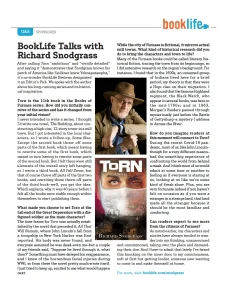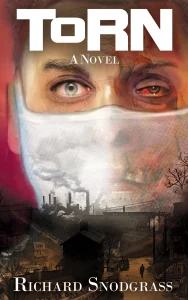At the beginning of World War I, John Lincoln Lyle, the son of a prominent family in his hometown of Furnass, PA, fell from a troop ship in New York Harbor; though it was thought he drowned, he actually survived but suffered hideous injuries to his face when struck by a ship’s propeller. As a result he must wear a mask in public, both for the protection of his wounds and to spare others the sight of his grotesque injuries. Now, twenty years later, he has returned unannounced to his hometown with unsettling results for everyone involved.

Here’s What They Are Saying About TORN
“With his latest novel, Torn, Richard Snodgrass presents a moving, unusual tale of a star-crossed, Depression-era family in the steel-mill town of Furnass, PA. It’s a story as emblematic in the making of small-town, industrial America as any hatched in Hollywood. A wayward son with a disfigured, masked face returns home long after WWI to tangle with his half-brother over the family factory and fortunes. Murder, fire and suicide occur, but pulsing beneath it all is a slow-building, redemptive love that blossoms with all the intensity and depth of a William Faulkner family saga.”
– Ron Arias
Author of The Road To Tamazunchale and Gardens of Plenty
“Deeply human story of a masked soldier’s return to a Depression-era mill town.”
– BookLife
Editor’s Pick

“Adding to an already impressive history of this fictional town, this latest intimate and enthralling tale is the best Furnass novel yet, bringing the town so sharply to life that readers easily forget it’s fictional.”
– Self-Publishing Review
“Evoking a very specific industrial small-town America that both appeared and disappeared during the 20th century. Aspects of this America are so concretely human as to feel mythic…”
– Indie Reader
“This thoughtful and emotionally complex tale (one of many by Snodgrass set in the fictional town of Furnass)… displays an impressive sensitivity to the profound ways in which a family’s present is shaped by its past.”
– Kirkus Reviews
The Increase in Facial Injuries in World War I
Because it involved trench warfare to a degree that hadn’t been experienced in European warfare before this time, World War I saw a terrible increase in traumatic facial injuries — the terrible result of soldiers having to raise their heads to look out of the trenches. For more information regarding the attempts to treat these horrific wounds, see “The Birth of Plastic Surgery” on the website of the UK’s National Army Museum. To see the heart-wrenching portraits of these victims by one of the participating surgeons and an artist in his own right, Henry Tonks, go to the Tonks Pastels at the Gillies Archives at the Collections of the Royal College of Surgeons, London and the Slade School, UCL.












